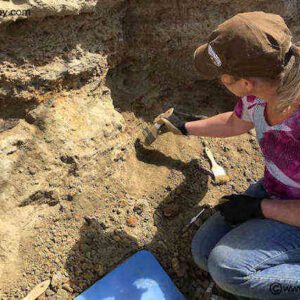What is the world’s largest amphibian? Scientists have just come up with a new answer to a question that one would think might be settled by now.

Broadly speaking, we already knew that the largest amphibians are the giant salamanders of China. They can grow more than five feet in length and well over 100 pounds.

Only a few decades ago they could still be readily found throughout China, from the subtropical south to the north-central mountains to the eastern part of the country.

Despite being found over such a wide area, and in areas separated by mountains and consisting of separate rivers, researchers have considered them to be a single species, Andrias davidianus.

But new research of museum specimens shows that Chinese giant salamanders are not one, but rather at least three differentspecies.

And the species that is likely the largest of the three has been given a new name: Andrias sligoi, or the South China giant salamander, according to a study published September 17 in the journal Ecology and Evolution.

“It’s amazing in this day and age that it took until now to work out what the world’s largest amphibian is,” says study lead author Samuel Turvey, a conservation scientist with the Zoological Society of London.

The news comes at an urgent time for the animals. Andrias davidianus is already considered critically endangered, and the creatures are perilously close to going extinct in the wild, Turvey says.

The two new species are almost certainly in even worse shape, he adds. Properly identifying the creatures could lead to better conservation efforts.

– Urgent times –The animals are primarily threatened by habitat loss, poaching, and, most importantly, widespread farming of animals.

There are, in fact, millions of giant salamanders throughout China on farms, but these individuals appear to be members of the more widespread species, Andrias davidianus.

That’s partially a result of the fact that farming originated in central China, where this species is found, and they’ve since been spread throughout the country since the practice took off in the last few decades. The animals are prized as delicacies, and their meat can fetch high prices.

In the past, these farms often released many animals back into the wild in a misguided attempt to help them. This is a strategy has probably done more harm than good; due to the local variation, only the species unique to a specific area should be reintroduced there, Turvey adds.

Doing this could help spread diseases, as well as introducing competition and hybridization between the animals.

“It’s the wrongspecies being put in the wrong place,” he says.

Turvey and others looked for Chinese giant salamanders in the wild from 2013 to 2016 and found them in only four sites. However, all of these were likely released from farms, because their genetics didn’t align with that of the area.

“It’s incredibly sobering, and depressingnobody had realized the situation was that bad,” Turvey says. Results from this survey were published in a paper published in Current Biology in May 2018.

– Comparing genes –To conduct the study, the researchers examined museum specimens of giant salamanders collected many decades ago, before the widespread farming and movement of amphibians around the country (by humans).

Their analysis shows that salamanders began to diverge 3.1 million years ago, as the Tibetan Plateau rose, along with the Nanling Mountains, in south-central China.

This geographically separated the animals into at least three lineages, all of which are separate species, unique to the Yangtze River in the north, the Pearl River in the southwest, and various streams in the southeast.

These results follow from the unique geography and genetics of the groups, but the scientists don’t know what exact anatomical differences the separate species might have, due to the different ways in which the animals were preserved.

Some of the specimens are preserved in liquid, and others dry, which over the years in some cases have formed dried-out bits of “amphibian paper,” Turvey says.

Many of the samples are also young salamanders, lacking some characteristics seen in older individuals. Poaching pressure has made it such that the animals don’t grow to enormous lengths in the wild anymore, he adds.

It’s impossible to say at this point how full-grown adult salamanders of each species would differ from one another.

For the third species, the group hasn’t yet been able to describe it or name it, because they only have only DNA from tissue samples to work with, and not a complete animalspecimen, Turvey says.

The researchers hope the work will lead to more appropriate conservation actions going forward. Ideally, salamanders from farms could be screened and have their genetics identified, before potentially being bred and reintroduced to the wild.

“We’re in drastic danger of losing the world’s largest amphibians,” Turvey says.

.

.

.






